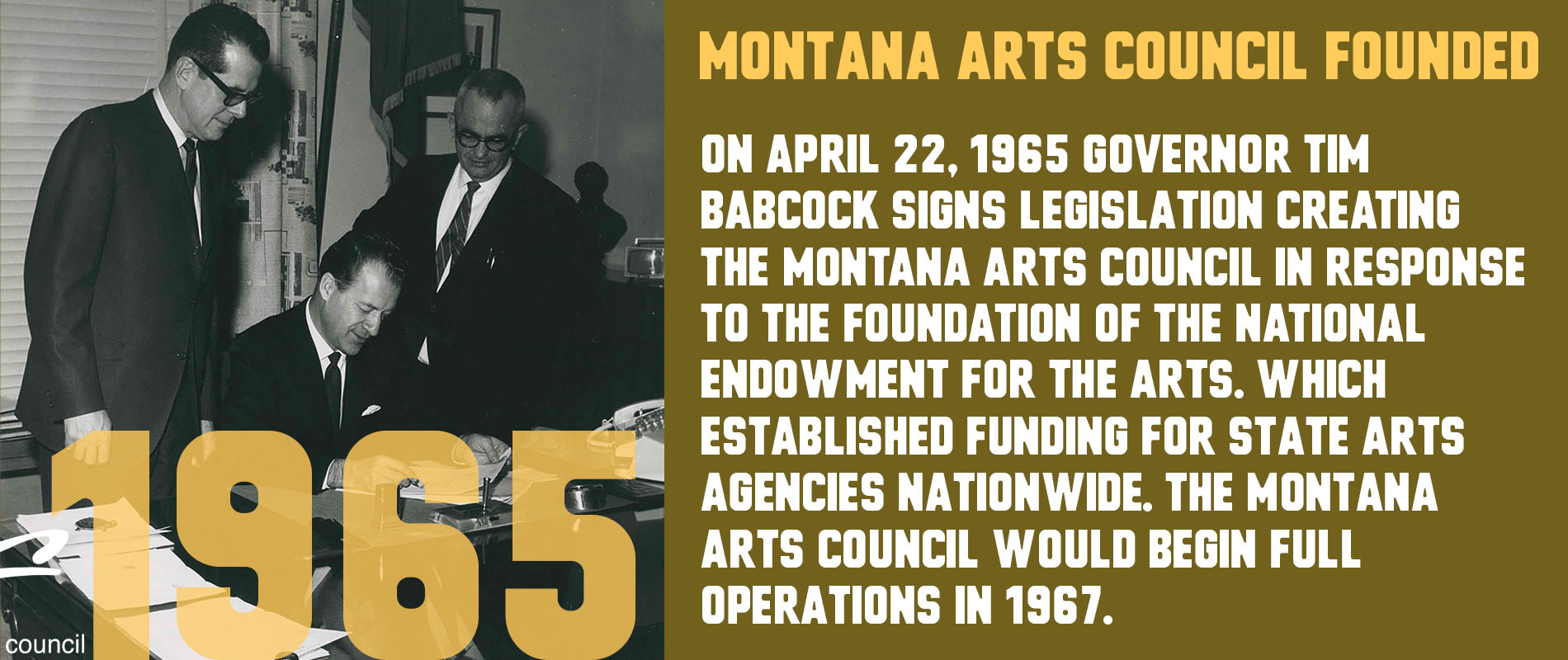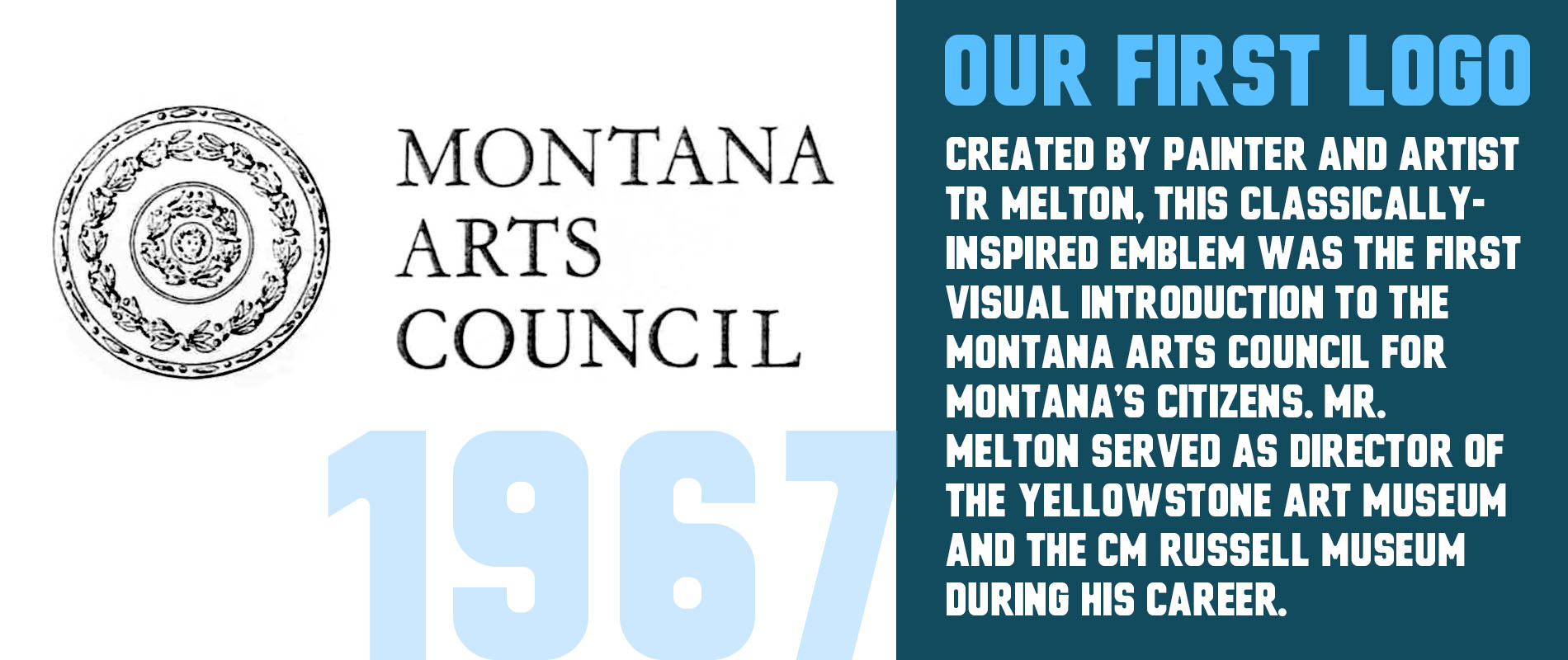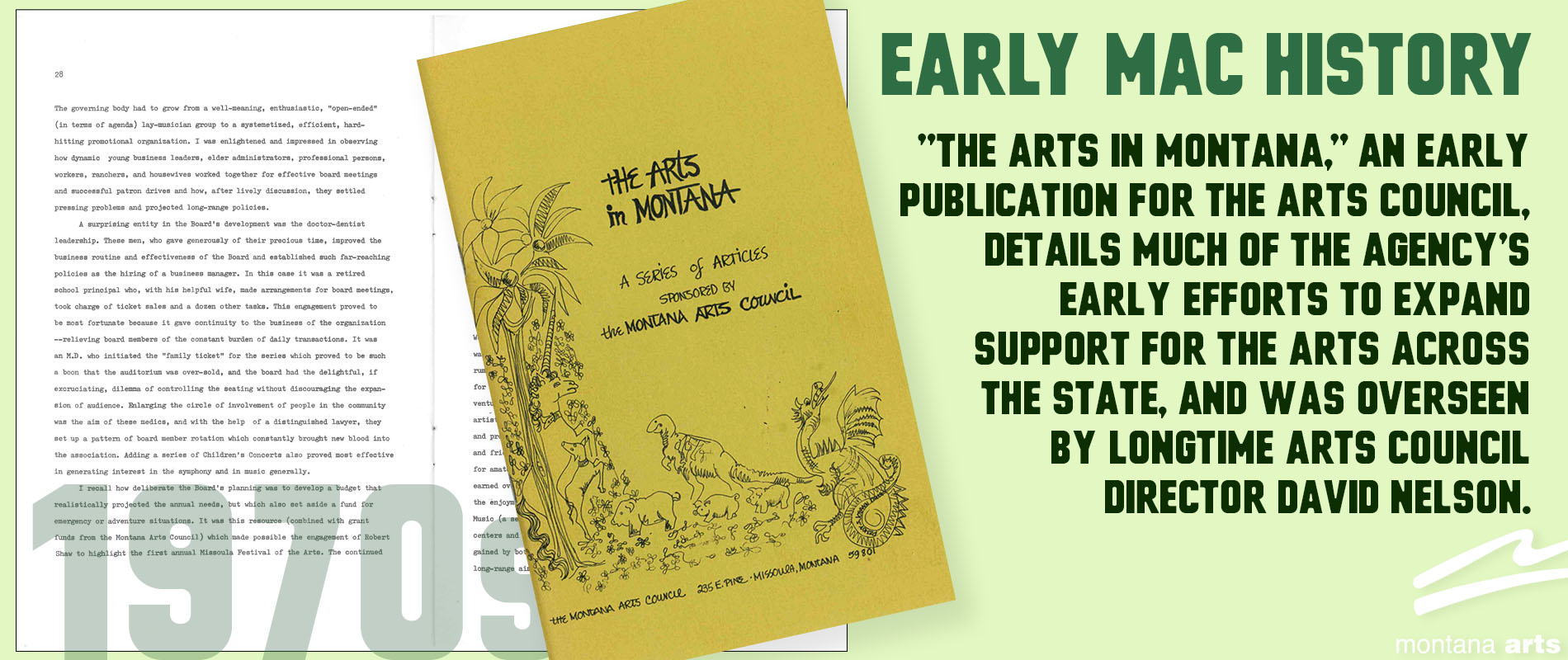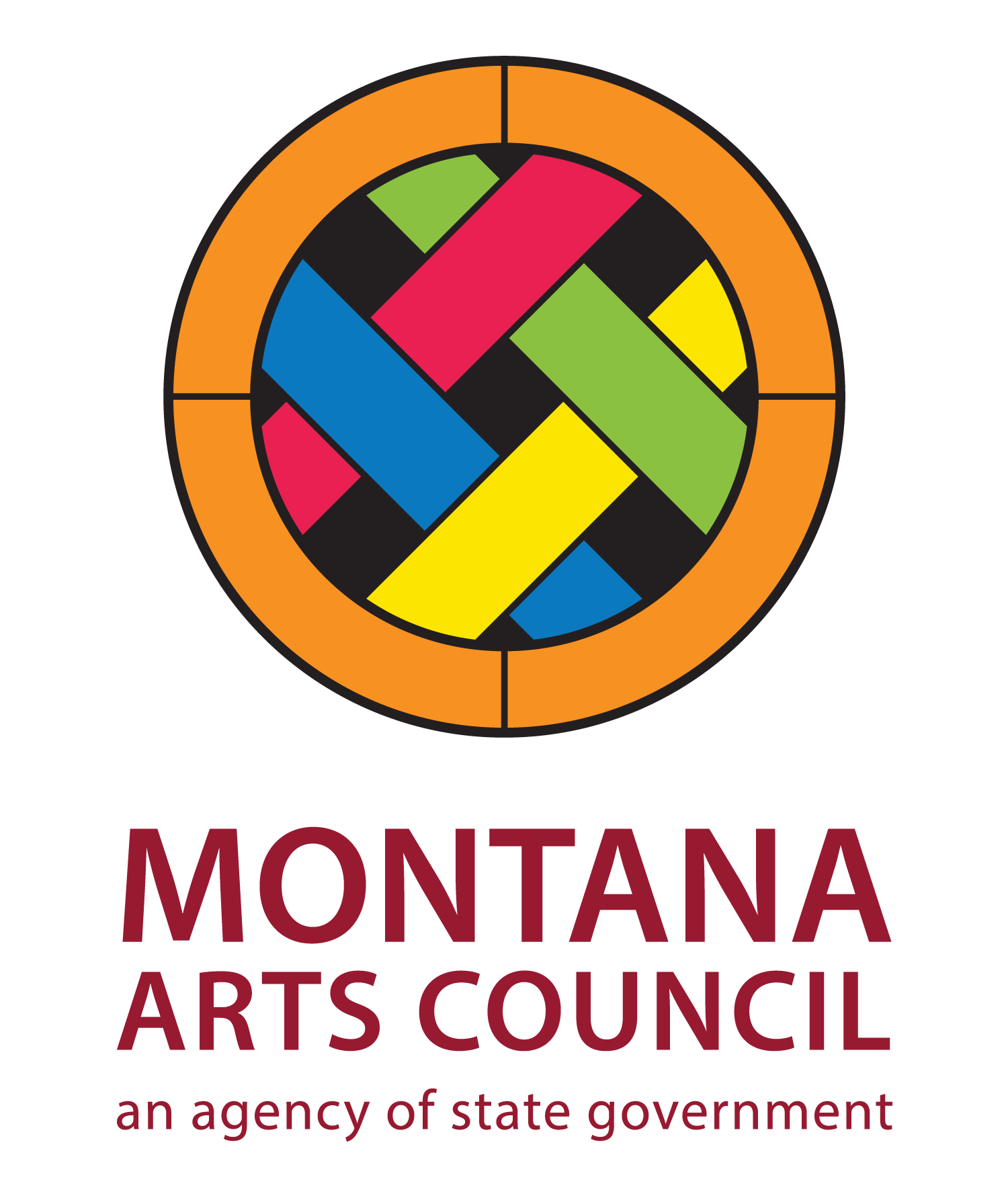

The Montana Arts Council was created by executive order of Governor Tim Babcock on April 22, 1965. Dean Charles Bolen of the School of Fine Arts at the University of Montana was the first Chairman. Late in 1966, after the first Governor's Conference on the Arts in Butte, the survey, of the arts in Montana, required by the National Endowment for the Arts was completed, and a report was submitted to the Governor and to the state. During the 40th Legislative Assembly, House Bill 12 made the Montana Arts Council an official agency of state government in 1967.
During the first years, the staff - a secretary, Jo-Anne Mussulman, and a part-time director, Luther Richman - ran the operation from free office space in the University of Montana, Fine Arts building on a budget of $12,000. The Council of 15 appointees distributed under $40,000 of National Endowment grant money.
The next legislature allocated $25,000 for each of the two years, but no program funds. A full-time director, Edward Groenhout, and the secretary moved to quarters near the mezzanine of the University of Montana Theater. This was the Montana Arts Council office for the next few years.
The Montana Arts Council survived executive reorganization only because of the vigilance of a former Montana Arts Council member who was also a legislator and lawyer. The Montana Arts Council was placed under the Board of Education for state budgetary purposes, along with the Historical Society and the Library Commission. Dean Bolen left Montana, and Dean Harold Rose of Montana State University was appointed as Chairman, a position, which he held until 1972 when he was appointed to chair another state board. At that time, Edward Groenhout left for an academic position at Montana State University. David Nelson was hired, as executive director and Maxine Blackmer, the Vice-Chairman, became the Chairman.
In 1970, a full-time coordinator, Pat Simmons, was hired for the Artists-in-Schools program, the Montana Arts Council's largest continuing statewide program. A modest increase in the Montana Arts Council staff (from two to four) and a vast increase in services necessitated a move to larger quarters off campus.
The state authorization of only 4 FTEs put a heavy burden on a dedicated staff. There were also several contract employees who worked for the Arts Council through the Montana Institute of the Arts Foundation. The major problem for the Council at that time was lack of state program support and additional authority to make others working for the council state employees, rather than as contractors through the Montana Arts Foundation.
The Basic State Grant from the National Endowment and additional federal program grants helped the Council to meet some of its requests.
In 1992, David Nelson and Jo-Anne Mussulman retired. Arlynn (Arni) Fishbaugh was hired as the Executive Director in November 1992. At the time, the staff had grown to 11 FTE, as authorized by the state. Larry D. Williams was Chairman of the council at the time. In 1994, Larry did not seek re-appointment so that he might serve as the Chairman of the WESTAF (Western States Arts Federation) Board. Attorney Bill Frazier, of Big Timber, was appointed as the new Chairman by Governor Racicot (who also appointed him to a second five-year term in 1999.)
The mid-1990’s saw substantial growth in federal funding to the council, reaching a high of $795,090 in 1996. The programmatic areas of the council flourished and included organizational and artist services, arts education, rural arts, folk arts, communications and administration of the Cultural Trust grants as well as agency administration.
The 1997 federal funding cuts resulted in a 40% reduction in Montana’s federal funding to the agency. The council made as a priority grant programs and restructured internally and reduced the number of staff by 40%.
The restructuring, that developed through 1998-2000, streamlined internal operations and grant procedures. Project grants for arts organizations were changed to operating support, the most valuable type of funding for these groups, and these grants were made biennial, rather than annual, awards. The arts education roster for artist residencies was eliminated, and an artist listing was developed instead, and all artist-in-Schools/Communities applications were done through the web. The council authorized the arts education director to approve all grants under $2000, and all other arts education grants were reviewed by an arts education committee of the council. Technical assistance was outsourced to the private sector through a new Arts Pro program, consisting of experts throughout Montana providing this aid and paid an hourly rate by the council. In addition, a Professional Development grant program was developed to fund artists and organizations’ professional development needs, such as workshops, trainings, conferences, etc. Immediate Action grants were changed to Opportunity Grants and artists were made eligible for funding, in addition to organizations, by treating those awards as contracts payable upon receipt of their expense receipts. Underwriting grants that funded individual presenters were changed to Tour Fee Support grants to fund Montana touring organizations, since 85% of the underwriting grants went to the same Montana touring companies. The agency’s bi-monthly newsletter ArtistSearch was greatly expanded to a tabloid 24-36 page newspaper renamed State of the Arts, and established a reputation as the country’s finest state arts agency newspaper.
During 1998-2000, staff restructuring aligned itself to these new priorities, and the increased demand for access to information through the world-wide-web and the need for increased database capabilities. Programmatic staff structure changed to also accommodate the skills of the people in, or being hired for, MAC positions. As a result, the directors of areas included Arts Education/Web Services, Grants/Database Development, Folk Arts, and Communications, coupled with the services of the Deputy Director/Accountant and an executive and an administrative assistant.
State general fund continued to grow very slowly, as it had since the agency’s inception. Following the devastating federal cuts in 1997, there was an increase in general fund to pay for the technical assistance programs newly developed.
During the late 1990s and early in 2000, the agency shifted priorities to build public awareness about the value of the arts and the arts council, as well as to reinforce the public value of supporting the arts throughout the state.
The “public value” work done by the agency since that time has established MAC as a national leader in this arena. The agency consistently ranks in the top group of state arts agencies in the country during NEA grant review. MAC has worked hard to keep money going out the door to constituents while keeping operations streamlined.
Launched in 2006, Public Value Partnership grants fund operating support for Montana’s staffed arts organization. These grants are the core of the agency’s grant programs, and all grant programs in the agency have a tie-in wherein grantees talk about the public value of the service/organization/effort that is being funded with state dollars.
The Artist Innovation Awards were established in the 2009, the Montana Circle of American Masters program and the Montana Artrepreneur Program (MAP) were established at approximately the same time. The MAP program, in particular, has become a national model for teaching artists marketing and business skill development. The agency received private foundation and U.S. Department of Agriculture funding for this highly successful program.
Federal funding has gone up and down since 2000. In FY2014, the agency experienced a cumulative 20% cut in federal funding. A small portion of this was offset by state general fund during the FY13 legislative session. During the time in which Governor Schweitzer was in charge, with the exception of his first year in office, there was no increase slated for the agency in his budgets. Efforts to have increased general fund from the state remained a challenge through the 2013 session.
2020 ushered in new challenges, not least of which was a global pandemic. COVID-19 affected every aspect of Montanans' lives, and the arts were not spared. The Montana Arts Council oversaw a massive effort to distribute relief funds in the form of CARES grants awarded to organizations and individuals to bridge the funding gaps caused by closures of performance and exhibition venues, educational facilities, and points of sale. In 2022 the Council is still working to help those in the arts recover from the pandemic as we continue to administrate our other grants, programs, and services.



